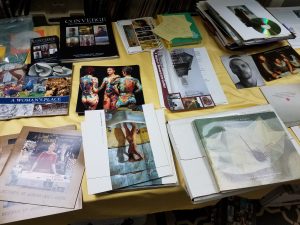“I can’t even look at it, it’s so bad!” Holding the innocent sketch in my hand I have to laugh at her recoiling. It’s so relatable – that cringe when we look back at the earliest efforts of a passion that we have since progressed in. Yet as an archivist – my response is to pick it back up after she moves it aside, to examine it closer, to try and understand this sketch’s place in the narrative of Alia El-Bermani. It has a place, it has meaning, it gives context, it is significant.
Alia is the artist who I am working with this semester for my artist fellowship. A figurative painter, Alia’s work has been exhibited all over the U.S. and the MEAM in Barcelona recently acquired her piece Paper Wishes for their permanent collection. Alia is also a teacher, at the college and workshop level, currently based out of her studio in Raleigh. She is a curator, her show SIGHT UNSEEN just opened last weekend at Abend Gallery in Denver. She is a champion for women artists, co-founder of the important blog Women Painting Women. She is a wife. She is a mother.
She is very many things and to capture all of that in an archive seems impossible to me. In the past, archives have come to me as is. The materials as the creator left them (hopefully), and as I talked about in my previous post on Kimowan Metchewais, I come to know the artist through their materials. Now I have both. The materials are here in my hands, and the artist is sitting next to me – the stories and memories of the pieces pouring out so quickly I feel at a loss to capture them. The anxiety of missing something, of losing an important part of the narrative is always there when archiving, but I find it increases tenfold when working directly with the originator. When working with the archives of creators whose lives I came across only once they were gone, I was haunted by the many questions I wished I could have asked them. Now, with the chance to ask those questions – I find myself overwhelmed by the richness of the answers.
What a wonderful problem to have. It is thrilling to know that the system we are developing, the inventory we are creating, will actually work for Alia. Despite her protests to contrary, Alia is an organized person, and moreover she has a clear sense of her workflow and process.
For example, working on her catalogs last week was fairly straightforward: deciding to categorize them into solo shows, group shows, and shows she curated, with a copy of each easily accessible and the rest in storage, made sense to both of us. A few weeks ago she came across a “mini-archive,” a childhood project on ancestor Clara Barton. To my delight, she immediately saw the value in preserving it, and another piece of her narrative was added to the puzzle. Right now we are still in the midst of detail work, the data-entry one piece at a time, and the big picture is still coming together.
Yet looking ahead to what this archive can accomplish once it is brought together is exciting. I was admittedly nervous going into this project – I had only known my creators as research subjects, slightly abstracted, always distanced in time and space. I never would have predicted that Alia would be the one teaching me. Working with her, artist as an actuality, not as subject, has me re-thinking, re-learning my role as archivist.
I will provide updates on my work with Alia as the internship progresses. In the meantime, the entire team is looking forward to our symposium this weekend. Be sure to catch the livestream if you can’t attend in person! All the video and materials from the day will also be made available afterwards through this site, and the fellows will recap through blog posts.



